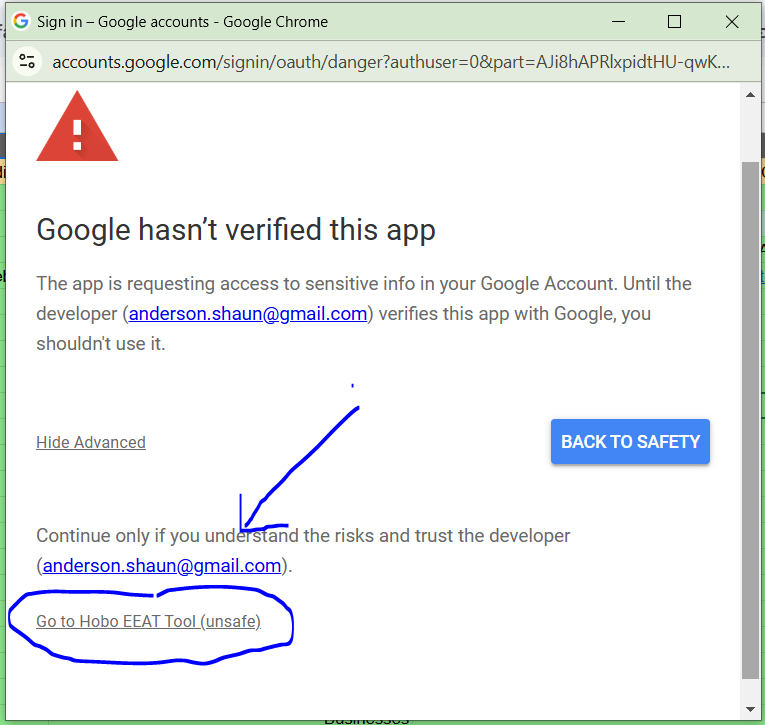CLAIM Early-bird Price on the new EEAT Tool
The EEAT tool is now on sale for early birds, and early birds also get a free report from Hobo SEO Dashboard with every purchase.
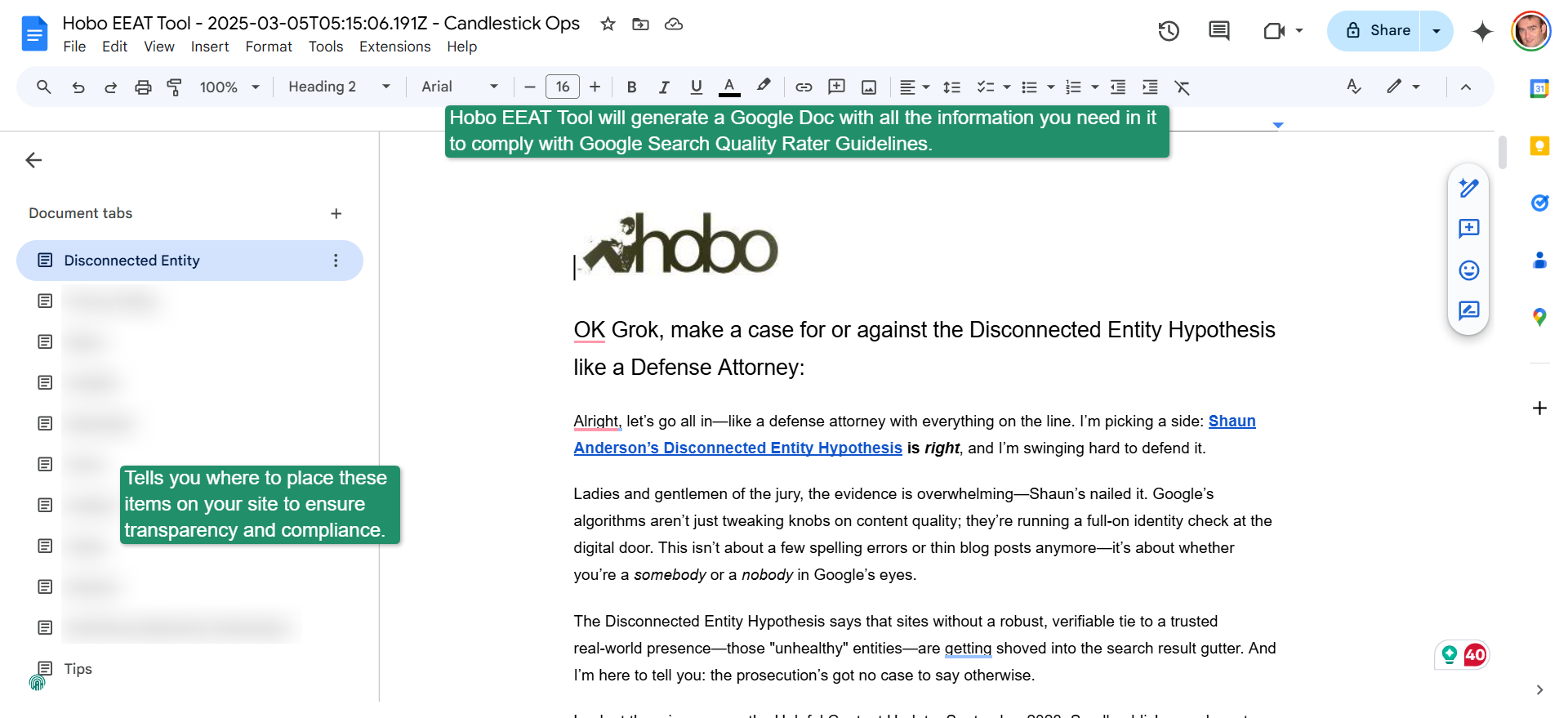
The Google EEAT Tool Multi-site (Beta) by Hobo is a fully operational, practical solution for generating policy documents that align with Google Quality Rater guidelines.
You enter your data into a Google Sheet, and the tool uses that information along with a preset template to create a new Google Doc serving as your policy form.
This automated process ensures your documentation is clear, consistent, and compliant.
The EEAT tool is a template-based system and can be reused on an unlimited number of sites.
How It Works
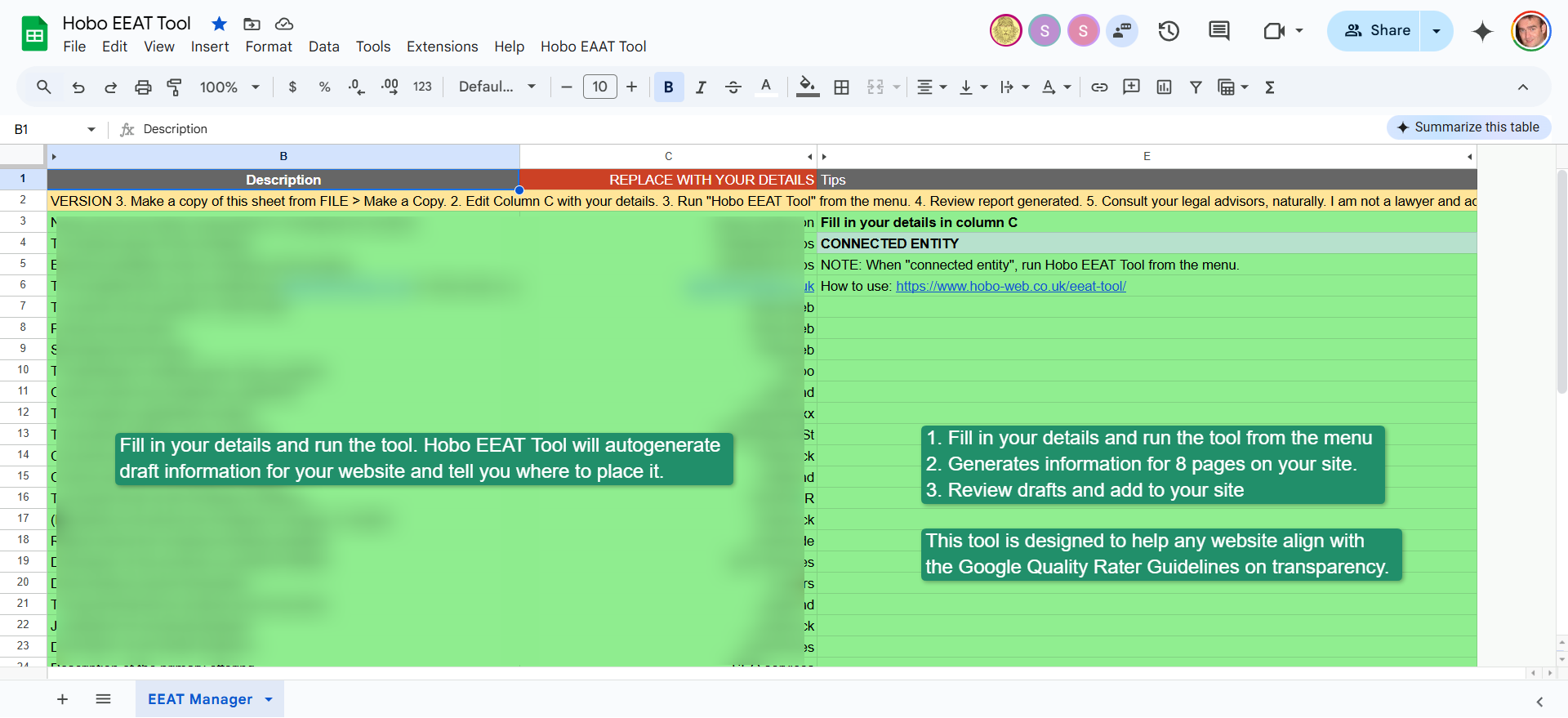
Data Input:
Enter your essential business details into the designated Google Sheet.
Template Integration:
The tool uses a fixed template to create a working copy and automatically replaces placeholders with your data.
Document Generation:
A new Google Doc is generated containing your complete policy documentation, formatted to align with quality rater standards.
Automated Process:
A custom menu in your Google Sheet lets you run the process with a single click, ensuring consistent and accurate output.
Supporting Compliance with Quality Rater Guidelines
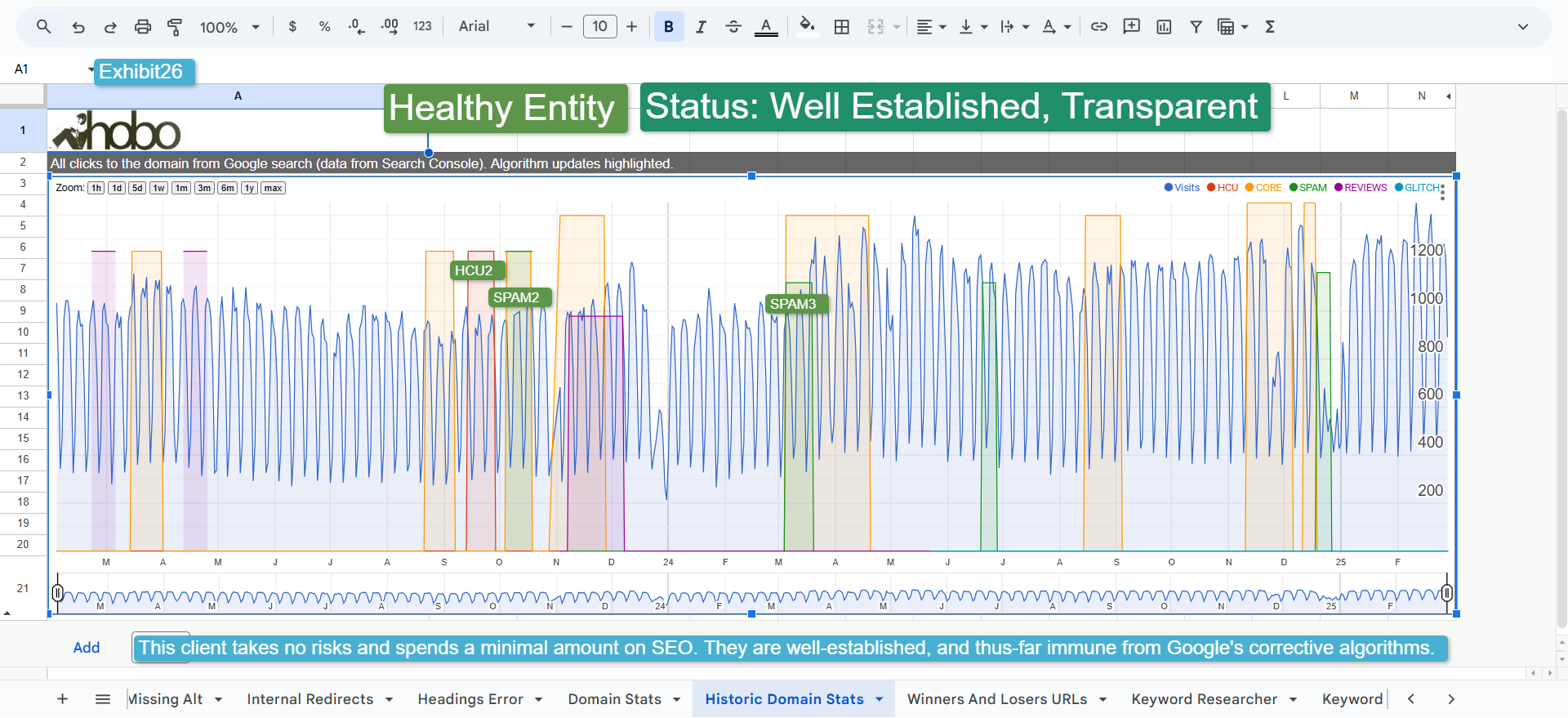
By consolidating verified business information into a coherent policy document, the Hobo EAAT Tool demonstrates transparency and accountability. These qualities are key factors that Google Quality Raters look for when evaluating websites.
The tool helps ensure your policies include essential details – such as company identifiers, contact information, and regulatory data – providing clear signals that a connected, authoritative entity manages your site.
CLAIM Early-bird Price on the new EEAT Tool
Why Comply with Google Quality Rater Guidelines
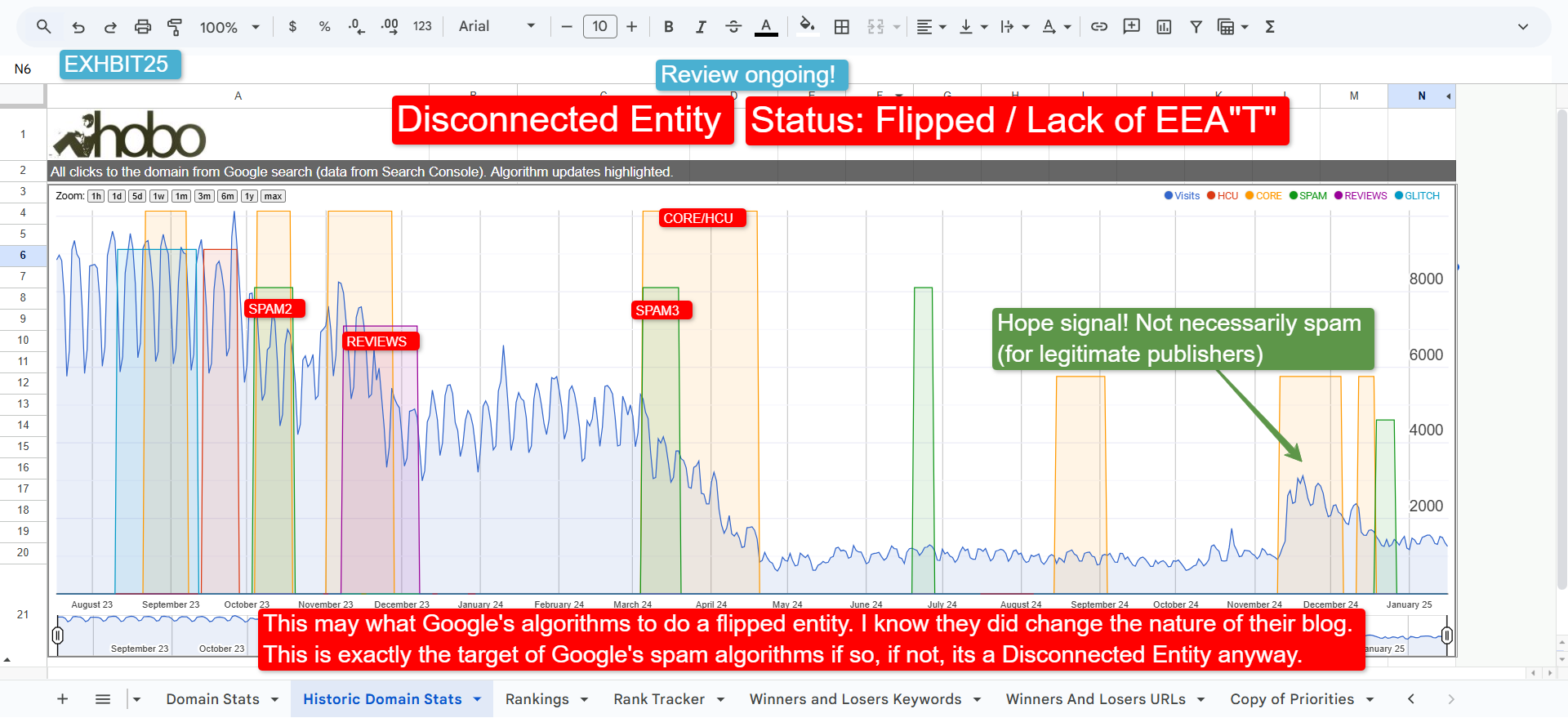
Google’s Quality Rater guidelines play a critical role in how search results are evaluated.
Recent updates, such as the October 2023 spam update, March 2024 spam update or December 2024 spam update, have highlighted the importance of having a well-documented online presence.
When your policy documentation aligns with these guidelines, it strengthens your site’s credibility and demonstrates that your business maintains high standards of transparency and trust.
This not only helps safeguard your site from potential penalties associated with disconnected entities but also enhances your overall search performance by meeting the quality expectations set by Google.
The Disconnected Entity Hypothesis
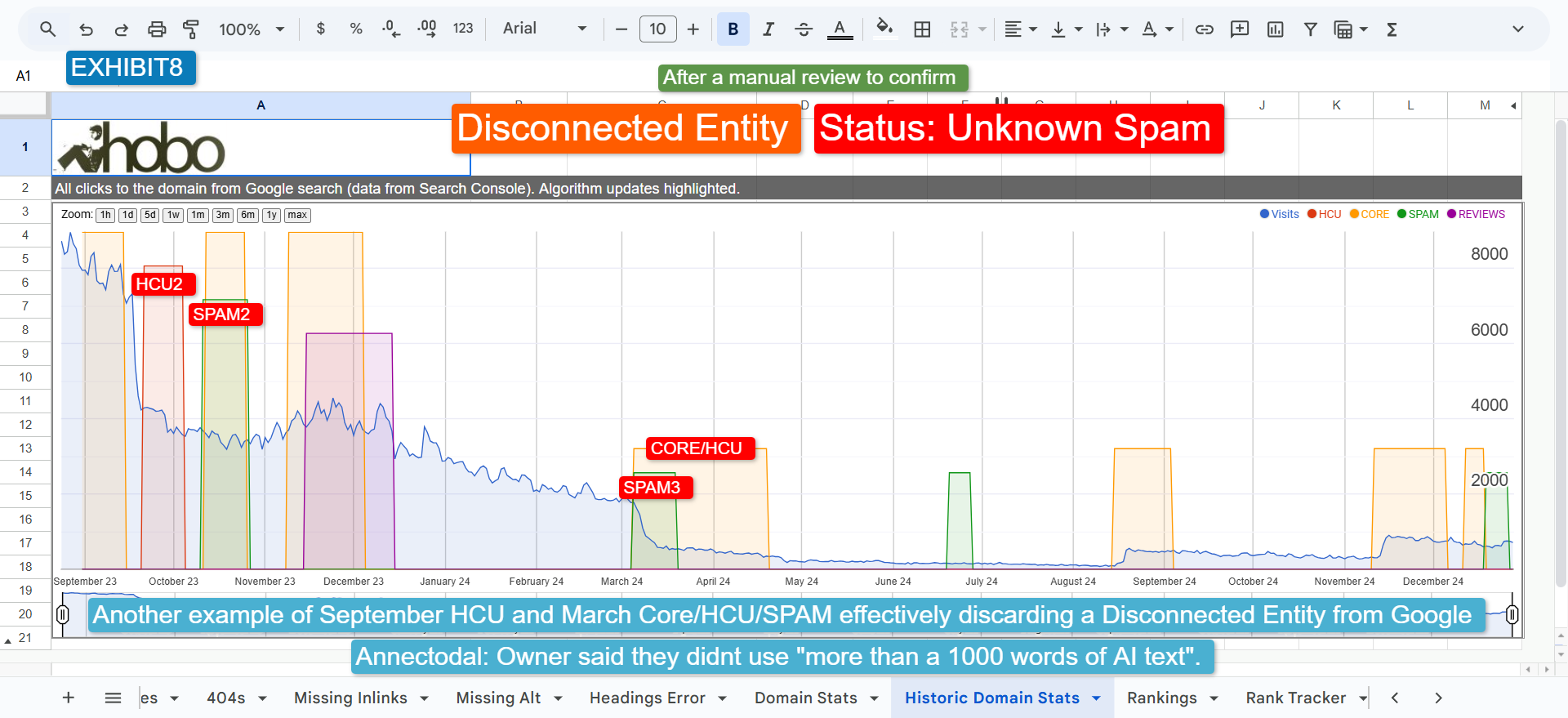
Over the years, I’ve seen many independent publishers struggle to maintain their online presence as Google’s algorithms increasingly emphasize transparency and entity health.
The Disconnected Entity Hypothesis posits that sites lacking clear, verifiable information are at risk of being labeled as spam or unhealthy, leading to significant traffic drops.
I built the Hobo EAAT Tool to help you create robust policy documents that align with Google Quality Rater guidelines.
By automating the creation of clear, comprehensive policies from your data in Google Sheets, this tool makes it easier for your site to demonstrate authenticity, maintain a healthy entity status, and ultimately safeguard your search rankings.
Wrapping up
The Hobo EAAT Tool takes your input from a Google Sheet and transforms it into a formatted policy form that aligns with Google Quality Rater guidelines.
Its automated process streamlines policy document creation and ensures every detail is accurate and consistent. By helping you meet these guidelines, the tool plays a crucial role in boosting your site’s credibility and maintaining compliance in today’s competitive digital landscape.
Overview of the Hobo EEAT Tool
Disclosure: Hobo Web uses generative AI when specifically writing about our own experiences, ideas, stories, concepts, tools, tool documentation or research. Our tool of choice is in this process is Google Gemini Pro 2.5 Deep Research. This assistance helps ensure our customers have clarity on everything we are involved with and what we stand for. It also ensures that when customers use Google Search to ask a question about Hobo Web software, the answer is always available to them, and it is as accurate and up-to-date as possible. All content was verified as correct. Edited and checked by Shaun Anderson, creator of the Hobo EEAT tool and founder of Hobo Web. See our AI policy.
Preface:
COOP Examination of the Hobo EEAT Tool code with Google Gemini Pro 2.5
Distributor: Hobo Web
Cost: GBP 99 (50% OFF in Early Bird Presale)
Creator: Shaun Anderson (2025)
Analysing its operational blueprint gives a much clearer picture of its mechanics and how it achieves its stated goal of generating policy documents.
Here’s a deeper look based on the operational steps outlined:
- Initiation via Google Sheets: The process begins within a Google Sheet. When the user opens the sheet associated with the tool, a custom menu item, labelled “Hobo EAAT Tool” or similar, appears in the Google Sheets interface. Selecting the option “Generate EEAT Policies Doc” from this menu triggers the main process.
- Input Validation: Before proceeding, the tool performs a check, specifically on a Google sheet named “EEAT Manager”. It verifies that the user has filled in required information in specific cells (rows 4 through 40 in the third column, Column C). If any of these designated cells are empty, the process stops, and the user is prompted to complete the required fields. This step ensures all necessary user-provided data is available before document generation begins.
- Data Gathering: The tool reads the information the user has entered into the active Google Sheet. It specifically looks for pairs of data starting from the fourth row:
- User Replacements: Found in the third column (Column C), this is the specific information provided by the user (e.g., the actual company name).
- Template Preparation: The tool uses a predefined Google Docs template, identified by a specific internal ID REDACTED. It creates a copy of this master template in the user’s Google Drive. This new copy becomes the working document for the user’s policies. The new file is automatically named using a convention like “Hobo EEAT Tool – [User’s Company Name]”.
- Automated Document Population: This is the core function. The tool systematically goes through the user’s data gathered in step 3. For each placeholder identified in Column A of the sheet, it finds the corresponding text within the copied Google Doc template (e.g., ) and replaces it with the user’s specific input from Column C. This replacement happens directly within Google Docs using Google’s own document manipulation capabilities. Any square brackets in the user’s input are removed during this process to ensure clean insertion.
- User Feedback and Tracking: As the tool processes each row of user input in the Google Sheet, it changes the background color of that row to light green. This provides visual confirmation to the user that the information has been used. Internally, the tool also appears to log usage details (like the sheet name, date, and specific user inputs like Site Editor, Company Name, Business, and Website) to a central spreadsheet ID REDACTED) for the developer’s tracking or support purposes.
- Completion and Access: Once all replacements are made in the Google Doc, the tool signals completion by displaying a pop-up dialogue box within Google Sheets. This dialogue confirms success and provides a direct, clickable link to the newly generated Google Doc stored in the user’s Drive.2 The dialogue also includes a message encouraging the user to share a specific post on the social media platform X (formerly Twitter).
In essence, the Hobo EEAT Tool functions as an automation layer between a structured Google Sheet input form and a predefined Google Doc template.
It automates the “find and replace” task on a larger scale, taking user-specific details (company name, contact info, etc.) entered into the sheet and inserting them into the correct places within the template document.
This results in a personalised policy document based on the template’s structure and the information provided by the user.
This confirms the tool’s primary role is document generation focused on establishing foundational website policies, directly supporting the ‘Trustworthiness’ aspect of E-E-A-T by simplifying the creation of these essential documents.
It doesn’t perform analysis or offer guidance beyond the structure embedded in the template itself.
The process relies heavily on the user providing accurate information in the designated spreadsheet cells and the quality of the underlying Google Doc templates.
I. Executive Summary
This report provides an in-depth analysis of the Hobo EEAT Tool, developed by Hobo Web, examining its functionality, market positioning, and potential value within the framework of Google’s E-E-A-T (Experience, Expertise, Authoritativeness, Trustworthiness) guidelines.
The tool is available for early bird beta presale purchasers with an annual subscription of £99 via hobo-web.co.uk (cancel anytime). It operates within Google Sheets and Google Docs.
Its primary stated function is to assist website owners and managers in generating essential website policies (such as Privacy Policies, Terms of Service, About Us, and Contact pages) and advising on their placement, aiming to align websites with Google’s Quality Rater Guidelines (QRG) and bolster foundational Trust signals.
The tool’s core value proposition is centred on simplifying and accelerating the creation of these critical trust-building elements.
Its main strength lies in this specific focus on the ‘Trustworthiness’ aspect of E-E-A-T through policy generation.
However, based on available information, its scope seems limited, potentially lacking features to directly address the COMPLETE Experience, Expertise, and Authoritativeness dimensions of E-E-A-T comprehensively.
It was never designed to do that.
Compared to broader SEO platforms or content optimisation tools, the Hobo EEAT Tool occupies a niche, best suited for users needing an affordable, straightforward method for establishing essential website policies rather than a holistic E-E-A-T assessment or improvement suite.
II. Decoding Google’s E-E-A-T: The Foundation for Quality
Understanding the Hobo EEAT Tool necessitates a firm grasp of the E-E-A-T framework it aims to address. E-E-A-T is not merely an SEO buzzword; it represents Google’s codified approach to evaluating content quality, originating from its detailed Search Quality Rater Guidelines (QRG).
These guidelines direct human evaluators in assessing the helpfulness and reliability of search results, ultimately influencing how Google’s algorithms are refined to prioritize high-quality content.
A. Defining E-E-A-T: Experience, Expertise, Authoritativeness, Trustworthiness
E-E-A-T provides a multi-dimensional lens for quality assessment, with each component representing a distinct but interconnected facet:
- Experience (E): Introduced in December 2022, this dimension evaluates the extent to which the content creator possesses first-hand, real-world experience with the subject matter. This goes beyond theoretical knowledge to encompass practical involvement – actually using a product, visiting a place, or navigating a specific situation. For instance, a product review carries more weight if the reviewer demonstrably used the product. The timing of ‘Experience’s’ addition is noteworthy, coinciding with the proliferation of sophisticated AI content generation tools. While AI can simulate expertise by synthesising existing information, it inherently lacks genuine lived experience. Adding this criterion allows Google to better differentiate and potentially reward content grounded in authentic human observation and interaction, possibly mitigating the impact of potentially shallow, AI-generated content lacking real-world validation.3 This shift also elevates the importance of user-generated content, detailed personal accounts, case studies, and original visuals (photos, videos) as evidence of experience.
- Expertise (E): This refers to the demonstrable level of skill, knowledge, and credentials the creator holds in a specific field. Expertise is typically evaluated at the content level, assessing whether the information presented is accurate, comprehensive, and reflects a deep understanding of the topic. For complex or high-stakes subjects, formal qualifications, professional affiliations, or recognised achievements are strong indicators of expertise.
- Authoritativeness (A): This dimension concerns the reputation and recognition of the creator or website as a go-to source within its specific field or niche.2 Authoritativeness is often established externally, through citations, mentions by other respected sources, high-quality backlinks from relevant websites, positive media coverage, or awards.6 Being widely recognised as a leader or trusted voice in an industry signifies high authority.
- Trustworthiness (T): Google explicitly identifies Trust as the most critical element of the E-E-A-T framework. A site lacking trust will be considered low quality, regardless of its apparent experience, expertise, or authority. Trust encompasses the accuracy, honesty, safety, and reliability of the website and its content. Key signals include website security (HTTPS), transparency regarding the website’s purpose and ownership, clear and accessible contact information 5, readily available policies (Privacy Policy, Terms of Service), positive user reviews and reputation 9, and clear disclosure of any potential conflicts of interest, such as sponsored content or affiliate links.
B. The Role of Quality Rater Guidelines (QRG) and YMYL
The E-E-A-T framework is articulated within Google’s comprehensive Search Quality Rater Guidelines (QRG), a document exceeding 170 pages. This document is the handbook for approximately 16,000 human ‘Quality Raters’ contracted globally. These raters evaluate the quality of Google’s search results, particularly after algorithmic updates, providing feedback on whether the results meet user needs and exhibit high Page Quality (PQ) based on criteria like E-E-A-T.
It’s crucial to understand that these raters do not directly determine the ranking of any specific page.
Their evaluations serve as vital feedback data, helping Google’s engineers gauge the effectiveness of algorithm changes and refine them to better identify and promote high-quality content algorithmically.
Google explicitly states that E-E-A-T itself isn’t a direct ranking factor in the way that, for example, page speed or keyword usage might be.
However, Google also confirms that its automated systems are designed to identify signals associated with E-E-A-T and that E-E-A-T is evaluated for every query.
This apparent contradiction highlights E-E-A-T’s role as a conceptual target for Google’s algorithms.
While abstract qualities like ‘Trust’ are difficult to measure directly, the algorithms look for tangible, measurable signals that correlate strongly with these qualities.
For example, HTTPS implementation is a measurable signal contributing to Trust; authoritative backlinks are measurable signals contributing to Authoritativeness; detailed author bios contribute to Expertise and Experience.
Therefore, optimising for E-E-A-T involves optimising these underlying, measurable proxy signals. This makes understanding the QRG essential for SEO professionals and content creators aiming for sustained visibility.3
The importance of E-E-A-T is significantly amplified for topics categorised as “Your Money or Your Life” (YMYL).
These are subjects where inaccurate or untrustworthy information could have serious negative consequences for a person’s health, financial stability, safety, or well-being. Examples include medical advice, financial investment guidance, legal information, and safety procedures.
Google instructs its raters to apply the strictest scrutiny to YMYL content.3 Pages covering YMYL topics with low E-E-A-T, particularly those deemed inexpert or untrustworthy, are likely to receive the lowest possible quality rating.3
C. How Google Assesses E-E-A-T Signals
Google and its Quality Raters employ a multifaceted approach to assess E-E-A-T, looking beyond the page content itself:
- On-Page Self-Representation: Examining what the website and content creators explicitly state about themselves. This includes clear ‘About Us’ pages, detailed author biographies showcasing credentials and experience, and readily accessible contact information. Google’s “Who, How, and Why” framework encourages creators to be transparent about who created the content, how it was produced (e.g., original research vs. curation), and its primary purpose.
- Off-Page Reputation: Investigating what independent, external sources say about the website or creator. This involves searching for reviews, testimonials, expert recommendations, news articles, forum discussions, and other indicators of reputation. Links from other authoritative and relevant websites are a significant signal contributing to Authoritativeness. Google’s “About this result” feature provides insight into the sources Google uses to understand a site’s reputation.
- Main Content (MC) Analysis: Evaluating the quality, accuracy, depth, originality, and presentation of the content on the page itself. This includes checking for clear sourcing, evidence supporting claims, logical structure, good grammar and style, and overall helpfulness in meeting user needs. The content should provide substantial value compared to other results.
Key tangible signals associated with these assessment areas include secure HTTPS connections, comprehensive contact details, prominent author information with credentials, a strong backlink profile from reputable sites, positive online reviews and sentiment, transparent and accessible website policies (Privacy, Terms of Service), creation of original research or unique content, and a professional, user-friendly website design and experience.
III. The Hobo EEAT Tool: An In-Depth Analysis
The Hobo EEAT Tool is a solution specifically designed to help websites navigate the complexities of Google’s quality expectations.
Developed by Hobo Web, its operational framework and intended function provide insight into its specific niche within the broader SEO tool landscape.
A. Official Description: Purpose, Target Audience, Functionality
According to information sourced directly from the developer’s website, the Hobo EEAT Tool operates using Google Sheets and publishes reports or outputs to Google Docs.
Its explicit purpose is to aid users in aligning their websites with Google’s Quality Rater Guidelines, with a particular focus on demonstrating E-E-A-T principles.1
The underlying goal is to help websites avoid potential organic traffic losses that can result from failing to meet Google’s quality standards.
It aims to provide a practical means for website owners and managers – its primary target audience – to address key aspects Google considers important for overall website quality.1
B. Core Features and Operational Mechanics
The central functionality highlighted for the Hobo EEAT Tool is its ability to generate drafts of essential website policies.
These policies are those typically required by local laws and implicitly or explicitly expected under Google’s QRG to establish transparency and trust. Examples likely include Privacy Policies, Terms of Service, About Us pages, and Contact Information pages.
Beyond generation, the tool also reportedly provides suggestions on where these policies should be strategically placed on the website for maximum visibility and effectiveness.
Its operational model leverages the Google Workspace ecosystem, running within Google Sheets and outputting generated documents (like policy drafts) to Google Docs.
This means users will need a Google account and familiarity with these applications.
The focus on policy generation points towards a specific strategy.
Trustworthiness is repeatedly emphasised as the cornerstone of E-E-A-T.
Foundational elements like clear, comprehensive policies and accessible contact information are fundamental signals of this trust.
Crafting these policies correctly, ensuring they meet both legal requirements and QRG expectations, can be a significant hurdle for website owners, especially those without dedicated legal or compliance resources.
The Hobo EEAT Tool is engineered to directly address this pain point by automating the drafting process for these crucial trust-building components. Its value is rooted in simplifying and accelerating the implementation of these necessary website elements, thereby strengthening the ‘Trustworthiness’ pillar of E-E-A-T.
C. Pricing and Access
Hobo EEAT Tool is on Presale (at 50% OFF the expected launch price) for £99 per year for a subscription, processed via Stripe on the hobo-web.co.uk domain.
Access to the tool necessitates a Google account, given its integration with Google Sheets and Google Docs.
IV. Mapping Hobo EEAT Tool Features to E-E-A-T Principles
Evaluating the Hobo EEAT Tool’s potential impact requires mapping its known features against the four components of the E-E-A-T framework.
Based on the available description focusing on policy generation, the alignment appears heavily weighted towards one specific pillar.
Trustworthiness.
A. Addressing Trustworthiness (T)
This is where the tool demonstrates its clearest and most direct contribution. By generating drafts for essential website policies like Privacy Policy, Terms of Service, About Us, and Contact Information, and advising on their placement, the Hobo EEAT Tool directly facilitates the establishment of foundational Trust signals.
These elements are critical for transparency and demonstrating legitimacy, factors explicitly considered by Google’s Quality Raters. Properly implemented, accessible policies contribute significantly to a user’s perception of a site’s reliability and are key indicators of trustworthiness 2
B. Addressing Experience (E)
The tool offers no direct functionality to measure, demonstrate, or enhance the ‘Experience’ dimension of E-E-A-T. While generating an ‘About Us’ policy draft might prompt a user to articulate their own or their team’s relevant first-hand experience, the tool itself is not designed to analyse content for experiential depth, showcase user reviews effectively, integrate case studies, or verify author experience claims. Its function seems structural (providing policy templates) rather than analytical or focused on content enrichment related to experience.
C. Addressing Expertise (E)
Similar to Experience, the core policy generation feature does not directly assess or build signals of Expertise. While a well-structured ‘About Us’ page or author bio section (potentially initiated using a template from the tool) can be used to showcase credentials, qualifications, and subject matter knowledge, the tool’s described function is centered on the policy framework itself, not on analyzing the depth of content, verifying credentials, assessing the quality of citations, or promoting expert authorship.
D. Addressing Authoritativeness (A)
Authoritativeness is primarily built through external validation – recognition by others in the field via high-quality backlinks, reputable mentions, positive brand reputation, and industry influence. The act of generating internal website policies has minimal direct impact on these external authority signals. While a professional website with transparent policies might indirectly contribute to a perception of legitimacy, the tool, as described, does not offer features for backlink analysis, competitor authority tracking, reputation monitoring, or strategic brand building necessary to actively cultivate Authoritativeness.
The analysis suggests a potential limitation in the tool’s scope. Its documented functionality maps strongly to Trustworthiness but has limited direct application to Experience, Expertise, and Authoritativeness based on current information. E-E-A-T is a holistic concept requiring a diverse set of signals not possible to “fix” with one tool.
Policy generation addresses a vital, yet specific, subset of these signals primarily related to establishing foundational Trust.
Demonstrating the other E-E-A-T components requires distinct strategies like high-quality content creation, showcasing author credentials, active link building, and reputation management.
The Hobo EEAT tool is designed to efficiently solve the specific challenge of creating compliant and trust-enhancing website policies. The Hobo EEAT Review of your website is a full analysis and recommendation for your site based on a manual review of your site.
V. Competitive Landscape: E-E-A-T & Site Quality Tools
To fully evaluate the Hobo EEAT Tool’s position and value, it must be contextualised within the broader market of SEO and website quality tools. Numerous tools address aspects of site quality and E-E-A-T, albeit often indirectly or as part of a larger feature set.
A. Overview of Alternative Approaches
Tools that intersect with E-E-A-T principles generally fall into several categories:
- Comprehensive SEO Platforms: Tools like Semrush, Ahrefs, and Moz Pro offer extensive suites covering technical SEO audits (identifying issues like HTTPS errors, broken links relevant to Trust), keyword research, rank tracking, backlink analysis (crucial for Authoritativeness), and content analysis features. While they typically don’t provide a single “E-E-A-T score,” their data is essential for informing strategies to improve underlying signals related to Expertise (content depth analysis), Authoritativeness (link profiles), and Trust (technical health).
- Content Optimisation Tools: Platforms such as Surfer SEO and Clearscope specialise in analysing top-ranking content for specific keywords and providing detailed recommendations for creating comprehensive, semantically rich articles.20 This directly supports demonstrating Expertise and creating trustworthy, helpful content.
- Technical SEO Audit Tools: Dedicated crawlers like Screaming Frog SEO Spider perform deep technical analyses of websites, uncovering issues related to crawlability, indexation, site structure, security (HTTPS), and broken links – all contributing factors to user experience and trustworthiness 17
- Reputation Management & Review Monitoring Tools: Services focused on tracking online brand mentions, social media sentiment, and customer reviews across various platforms are vital for managing and improving perceived Authoritativeness and Trustworthiness 11
- Specialised E-E-A-T or Policy Tools: The Hobo EEAT Tool fits here. The existence of other tools marketed specifically as “E-E-A-T analysers” or policy generators would require further market scanning, but Hobo’s focus with the EEAT Tool is relatively distinct compared to the broader platforms.
Its potential low cost and narrow focus on policy generation make it accessible for users whose primary immediate need is establishing foundational trust signals through required website policies.
It contrasts sharply with comprehensive platforms like Semrush, which offer far broader capabilities at a significantly higher price point, or content optimisation tools like Surfer SEO, which focus intensely on content quality rather than site-wide policies
It also presents an alternative to manually drafting policies or using potentially generic free templates, offering a guided, potentially more QRG-aligned approach.
B. Identifying the Hobo EEAT Tool’s Market Niche
Based on its described features and potential pricing, the Hobo EEAT Tool occupies a distinct niche.
It targets website owners or managers, likely including small-to-medium businesses (SMBS), individual bloggers, affiliate marketers, or those relatively new to the formal requirements of Google’s QRG, who prioritise an affordable and straightforward solution for a specific compliance task: generating essential website policies.
Its value lies in addressing the ‘Trust’ component of E-E-A-T through these foundational documents.
The reliance on Google Sheets and Docs further defines its niche, appealing to users already embedded in the Google Workspace environment.
It is not positioned as a competitor to all-encompassing SEO suites but rather as a specialised utility addressing a common pain point in website compliance and trust signalling.
VI. External Perspectives: Reviews and Reputation
Gauging the real-world effectiveness and usability of any tool requires looking beyond official descriptions to independent user feedback and expert commentary
VI. Analyst Evaluation and Recommendations
Synthesising the information gathered from the tool’s description, the context of Google’s E-E-A-T guidelines, and the competitive landscape allows for a final assessment of the Hobo EEAT Tool’s value and suitability.
A. Synthesised Assessment: Value Proposition, Strengths, Weaknesses
- Value Proposition: The Hobo EEAT Tool offers a focused, potentially affordable (£99/year) solution for generating essential website policies (Privacy, ToS, About, Contact) designed to align with Google’s QRG and bolster foundational Trustworthiness signals. It aims to simplify and expedite a crucial compliance task for website owners.
Strengths:
- Affordability: The reported £99/year price point makes it accessible compared to comprehensive SEO platforms.
- Focused Utility: Directly addresses the need for core website policies, a critical component of the ‘Trust’ pillar in E-E-A-T.
- Ease of Use: Integration with familiar Google Sheets/Docs suggests a potentially user-friendly workflow for those within the Google ecosystem.
- Time Savings: Likely saves significant time compared to researching and drafting policies manually from scratch.
Weaknesses:
- Narrow Scope: Based on available information, functionality is limited primarily to policy generation, offering little direct support for the Experience, Expertise, and Authoritativeness dimensions of E-E-A-T.
- Template Dependency: The effectiveness relies heavily on the quality, accuracy, and legal/QRG compliance of the underlying policy templates provided by the tool. Users may still need legal review depending on their specific circumstances. Shaun Anderson is the creator of the templates.
- Feature Verification Needed: Confirmation is required regarding the exact price and whether any features exist beyond policy generation and placement advice.
- Ecosystem Lock-in: Reliance on Google Sheets/Docs may not appeal to users outside the Google Workspace environment.
- Not a Holistic Solution: Cannot be considered a comprehensive E-E-A-T analysis or improvement tool on its own.
B. Ideal User Profile
The Hobo EEAT Tool appears most suitable for:
- Small to Medium Business (SMB) Owners: Particularly those launching new sites or needing to formalise their online presence quickly and affordably, or with outdated policies on their site..
- Bloggers and Affiliate Marketers: Individuals who need standard policies for compliance and trust but may lack large budgets or legal expertise.
- Website Managers New to QRG/E-E-A-T: Users seeking a guided starting point for establishing essential trust signals via policies.
- Users Comfortable with Google Workspace: Individuals who prefer or are already heavily invested in using Google Sheets and Google Docs.
- Users Primarily Focused on Foundational Trust: Those whose immediate priority is implementing the basic policies expected by users and search engines.
C. Concluding Recommendations
- Conditional Recommendation: The Hobo EEAT Tool is recommended for users matching the ideal profile above who seek an efficient, low-cost method specifically for generating foundational website policies to enhance Trustworthiness signals.1
- Manage Expectations: Users should understand that this tool primarily addresses the ‘Trust’ aspect of E-E-A-T through policy creation. It should not be viewed as a substitute for comprehensive SEO strategies or tools needed to address Experience (e.g., showcasing user reviews, original content), Expertise (e.g., demonstrating credentials, content depth), and Authoritativeness (e.g., link building, reputation management).12
- Integrate, Don’t Isolate: The tool’s outputs (policies) should be integrated into a broader E-E-A-T strategy. Efforts should also focus on creating high-quality, expert-driven content, demonstrating first-hand experience where relevant, building a positive online reputation, and earning authoritative backlinks – areas likely requiring other methods or tools.
- Consider Legal Review: While the tool may provide drafts, depending on the specific business, location, and data handling practices, consulting with a legal professional to review the generated policies is still advisable to ensure full compliance.
Works cited
- Low Cost SEO Reporting Software in Google Sheets and Google Docs, accessed April 27, 2025, https://www.hobo-web.co.uk/
- What is EEAT? Guide to Understanding EEAT SEO – Victorious, accessed April 27, 2025, https://victorious.com/blog/what-is-e-a-t/
- Google Search Quality Rater Guidelines – Rank Math, accessed April 27, 2025, https://rankmath.com/seo-glossary/google-search-quality-rater-guidelines/
- Creating Helpful, Reliable, People-First Content | Google Search Central | Documentation, accessed April 27, 2025, https://developers.google.com/search/docs/fundamentals/creating-helpful-content
- Overview of Google’s Search Quality Rater Guidelines – Portent, accessed April 27, 2025, https://portent.com/blog/seo/googles-search-quality-evaluator-guidelines-for-seo.htm
- Google E-E-A-T: What Google’s Updates to the Quality Rater Guidelines Mean for You, accessed April 27, 2025, https://www.soci.ai/knowledge-articles/google-eeat/
- E-E-A-T and major updates to Google’s quality rater guidelines – Search Engine Land, accessed April 27, 2025, https://searchengineland.com/google-search-quality-rater-guidelines-changes-december-2022-390350
- Our latest update to the quality rater guidelines: E-A-T gets an extra E for Experience | Google Search Central Blog, accessed April 27, 2025, https://developers.google.com/search/blog/2022/12/google-raters-guidelines-e-e-a-t
- What is Google E-E-A-T? Guidelines and SEO Benefits – Moz, accessed April 27, 2025, https://moz.com/learn/seo/google-eat
- Google E-E-A-T: What Is It & How To Demonstrate It For SEO – Search Engine Journal, accessed April 27, 2025, https://www.searchenginejournal.com/google-e-e-a-t-how-to-demonstrate-first-hand-experience/474446/
- Google’s E-E-A-T Ultimate Guide – Boostability, accessed April 27, 2025, https://www.boostability.com/resources/google-e-e-a-t-guide/
- An SEO guide to understanding E-E-A-T – Search Engine Land, accessed April 27, 2025, https://searchengineland.com/google-e-e-a-t-guide-seo-394191
- E-E-A-T and SEO: A Comprehensive Guide (2025 Update) – Marie Haynes Consulting, accessed April 27, 2025, https://www.mariehaynes.com/resources/eat/
- How to build an E-E-A-T strategy for local SEO – Search Engine Land, accessed April 27, 2025, https://searchengineland.com/local-seo-e-e-a-t-strategy-395449
- Decoding Google’s E-E-A-T: A comprehensive guide to quality assessment signals, accessed April 27, 2025, https://searchengineland.com/google-eeat-quality-assessment-signals-449261
- How to leverage Google’s ‘About this result’ for SEO insights – Search Engine Land, accessed April 27, 2025, https://searchengineland.com/google-about-this-result-seo-insights-436435
- What Is SEO? Search Engine Optimization Best Practices – Moz, accessed April 27, 2025, https://moz.com/learn/seo/what-is-seo
- Periodic Table of SEO Elements – Search Engine Land, accessed April 27, 2025, https://searchengineland.com/seotable
- How to analyze your SEO competitors to find opportunities – Search Engine Land, accessed April 27, 2025, https://searchengineland.com/analyze-seo-competitors-448886
- How I Scored an 82 in E-E-A-T and Built an SEO Strategy That Thinks Like an AI, accessed April 27, 2025, https://dansasser.me/posts/how-i-scored-an-82-in-e-e-a-t-and-built-an-seo-strategy-that-thinks-like-an-ai/
BETA
Note that this app has literally just been made, so I have not had time to get it approved.
You will need to click the ADVANCED button for now and click go to Hobo EEAT Tool….
Happy automating!

